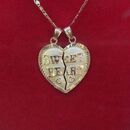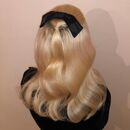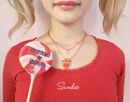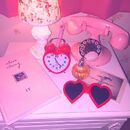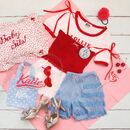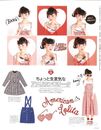This is a sensitive topic. Many would argue that buying into this aesthetic and subculture is not far from romanticize of pedophilia. Please research the implications of this style thoroughly before making the decision to involve yourself in it. If this makes you uncomfortable but you do like the look, you can still be a part of the Nymphet community and frown upon people in the community who do romanticize pedophilia.
It's still necessary to acknowledge even harmful influences on modern visual culture, but we at the Aesthetics Wiki DO NOT condone the romanticize of pedophilia and child abuse.

Nymphet is an aesthetic based on a novel written by Vladimir Nabokov - "Lolita", published in 1955 and it's movie adaptations from 1962 and 1997. Nymphet is a young girl, who is attractive and sexually mature, but still has childlike behavior and innocence. As an aesthetic, this word refers to the style of Dolores Haze in the movies, that influences the fashion nowadays. It mostly revolves around youth, summer dresses, carefree fun and flirting, with some going the extra mile and partaking in relationships with big age gaps (though most members in the Nymphet community frown upon this sort of behavior).
History and Controversy
Vladimir Nabokov intended his novel to be a critique on beauty and how it can hide true evil, portray Humbert Humbert as a pedophilic abuser, and showed Dolores as a young girl who is only "sexually mature" as a result of grooming and the warped narrative of the villain-protagonist. Of course, multiple audiences were unable to see his themes and took it at face value, falling into Humbert's spell. This was further complicated with Stanley Kubrick's film adaptation of the novel. In it, Dolores was portrayed by 15-year-old post-pubescent Sue Lyon, a great age difference from 12-year-old Lolita. Kubrick's own direction had not made it explicitly clear that Dolores's "seduction" was in the mind of Humbert. Though when the Nymphet aesthetic first became popular, many romanticized Humbert and Dolores' relationship. However, it's highly frowned upon to romanticize "Lolita" and call it a love story by those in the community nowadays, and many have cited Nabokov's true intention of the novel to rebuke those standpoints. Most of those in the Nymphet community solely like the aesthetics related to the novel and film. In recent years, "Doelette" rose as a subcategory to the Nymphet aesthetic, though it's mostly a mix of traumacore and Nymphet.
Teen girls are victims to society's over-sexualization. Some young women who feel sexual/romantic attraction to their teachers, friends' fathers, and other men may seek these sorts of relationships and try to seduce them. Of course, it is the adult's responsibility to end this. Society's portrayal of teenaged girls also pressures young women to be more sexual. Movies would romanticize and normalize age gaps, display sexual promiscuity in high school, and shame modesty and indifference towards sex. As such, some young women might pursue the relationship and aesthetic to gain approval from society.
Visuals
Nymphet visuals focus heavily on adolescence and the gateway between childhood and adulthood.
Media
Movies
- "Lolita" (1962), (1997)
- "Leon the Professional" (1994)
- "American Beauty" (1999)
- "The Crush" (1993)
- "Pretty Baby" (1978)
- "Breezy" (1973)
- "Hick" (2011)
- "Copenhagen" (2014)
- "The Diary of a Teenage Girl" (2015)
- "Jeune et Jolie" (2013)
- "The Lover" (1992)
Music
- "Lolita", "Put me in a movie", "Off to the Races" - Lana del Rey
- "My Heart Belongs to Daddy" - Marylin Monroe
- "Guys My Age" - Hey Violet
- "You're Sixteen" - Ringo Starr
- "Lolita" - Knee High Fox
- "Moi... Lolita" - Alizee
- "Girls In Their Summer Clothes" - Bruce Springsteen
Fashion
Note: This fashion should not be confused with Lolita fashion, a Japanese street fashion that is heavily inspired by Rococo and Victorian era clothing, which has entirely different rules and mentality behind it, and is no way related to Nabokov's "Lolita", despite sharing its name.
Face and Makeup
- Clean, dewy skin
- Rosy cheeks
- Highlighter to achieve soft glow
- Pastel and shimmery eyeshadows
- Long eyelashes
- Red lipstick
- Glittery and sheer glosses in pink, red or peachy tones
Hair
- Long natural hair
- Braids
- Soft waves and curls
- Milkmaid braids
- Pigtails
- "Donut"/looped braids
Clothing
- Sundresses
- Rompers
- Tennis skirts
- High-waisted shorts
- Cropped tops
- Plaid/floral/cherry patterns
- Thigh-high and knee-high socks
- Mary Jane shoes
- Sandals
- Red/white/pink/baby blue clothes
- Bralettes
- Preppy clothes
- Clothing with lace
Accessories
- Heart-shaped sunglasses
- Ribbons/bows/hairbands/cute hair accessories in general
- Cute, soft necklaces
- Delicate chokers
- Small earrings
- Lollipops
- Vintage backpacks
- Stockings and cute socks
- Bubblegum and candies
- Cherries or strawberries
Activities
- Baking or cooking for one's friends or family
- Chewing bubblegum
- Dancing, particularly in a modern or lyrical style
- Eating fruits and certain sweets
- Fashion or shopping at thrift stores
- Going to parties
- Maintaining a carefree and childlike demeanor
- Painting one's nails in bright, girlish colors
- Risque party games such as spin-the-bottle or seven minutes in heaven (played straight)
- Rollerskating, running or riding a bicycle
- Writing physical letters with paper and pen
Subgenres
Faunlet
Faunlet is the male equivalent to a Nymphet. The main inspirations for the aesthetic are Tadzio from the 1971 adaptation of Death in Venice, Leonardo DiCaprio and vintage boys clothes, especially sailor clothes and woodland themes and colours.
The Faunlet aesthetic does seem to have more of a following in the LGBTQ community than in heterosexual circles, though theoretically, one could be involved in the Faunlet community and be straight (but it's nowhere near as common).
Gallery
| This page is a candidate for deletion.
Remember to check what links here and the page history before deletion. |

